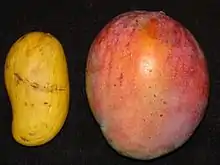Ataulfo (mango)
The 'Ataúlfo' mango, also called young, baby, yellow, honey, Adaulfo, Adolfo, or Champagne,[1] is a mango cultivar from Mexico.[2] Ataulfo mangos are golden yellow and generally weigh between 6 and 10 ounces (170 and 280 g), with a somewhat sigmoid (oblong) shape[2] and a gold-blushed yellow skin.[3] Their buttery flesh is not fibrous, and they have a thin pit. Their flesh is a deep yellow and high in sugar (15 grams per 100-gram serving), with a rich, sweet flavor. They were named for grower Ataulfo Morales Gordillo.[4]
| Mangifera 'Ataúlfo' | |
|---|---|
 Ataúlfo mango (left), Tommy Atkins (right) | |
| Genus | Mangifera |
| Species | Mangifera indica |
| Cultivar | 'Ataúlfo' |
| Marketing names | Champagne |
| Origin | Soconusco, Chiapas, MX |
Origin
The Mexican Institute of Industrial Property (Instituto Mexicano de la Propiedad Industrial) granted the designation of origin of this fruit to the government of Chiapas.[4] Along with the Manilita mango, it is a descendant of the Philippine mango cultivar introduced from the Philippines to Mexico before 1779 through the Manila-Acapulco galleon trade. It was crossed with other mango varieties, resulting in the Ataulfo. Regardless, Ataulfo remains a Philippine-type mango, characterized by being polyembryonic (as opposed to the Indian-type which is monoembryonic).[5]
In 1958, the agronomist Hector Cano Flores (the discoverer of Ataulfo mango) reportedly made a clone of an Ataulfo mango which he named IMC-M2.
In 2003, the Mexican government, through the Official Gazette, published Comunicado No. 14 – 2003 titled “Abstract of the application for the declaration (protection) of the Appellation of Origin: Mango Ataulfo del Soconusco Chiapas,” a declaration that the term “Mango Ataulfo del Soconusco Chiapas” is an appellation of origin for a specific kind of mango fruit produced in several regions of Chiapas, Mexico[6] where the Ataulfo was first grown by Ataulfo Morales Gordillo.[4]
Production
The fruit grows in warm, moist climates with summer rains, but monsoon temperatures must not decline to 41 °F. The proper temperature for this type of mango is 83 °F with rainfall between 1090–3000 mm annually, from April to October.
The Ataulfo mangoes originate in the Mexican states of Michoacan, Sinaloa, Nayarit, Jalisco, Veracruz and Chiapas, and are sold between March and September.[3] In the Mexican state of Chiapas, mango production was, as of 2008, the sixth most important agricultural activity, based on cultivated surfaces, following corn, beans, coffee, sugar cane and cocoa. Ataulfo production in that state was concentrated in the Soconusco coastal region. Overall, producer organizations estimated that there were 18,000 hectares of Ataulfo mangoes in production in the state.[7]
Consumption
Ataulfo mangoes gained popularity in the United States beginning in the late 1990s,[8] though they have been a major crop in Mexico for decades.[4][2] As of 2009, they were the second-most popular variety of mango sold in the U.S., behind the Tommy Atkins.[9] As of 2018, they represented a little less than 20% of all mangoes imported into the U.S.[10]
Until 2014, Mexican ataulfo mangoes had not been sold in significant numbers in Europe because shipping them by air was prohibitively expensive.[11] In December 2014, shipments by sea began via one United Kingdom importer using timed pre-ripe harvesting combined with faster sea-shipping that enabled full mango ripening while in transit.[11] European customers are willing to pay significantly more than North American customers, if the mangos are of high quality and are sold ready-to-eat.[12]
References
- Krystal, Becky (April 16, 2018). "How to prep and enjoy a mango, the sunniest fruit in the grocery store". Washington Post. ISSN 0190-8286. Retrieved June 22, 2018.
- Allen Susser. The Great Mango Book. Ten Speed Press (2001), p. 6 ISBN 1-58008-204-1.
- Corey Mintz (May 24, 2008). "Sweet news: Ataulfos are in season; It's hard to believe these silky mangoes are related to the stringy variety we see in winter". Toronto Star.
- "Ataulfo mangoes". Specialty Produce. 2016. Retrieved 20 October 2016.
- Rocha, Franklin H.; Infante, Francisco; Quilantán, Juan; Goldarazena, Arturo; Funderburk, Joe E. (March 2012). "'Ataulfo' Mango Flowers Contain a Diversity of Thrips (Thysanoptera)". Florida Entomologist. 95 (1): 171–178. doi:10.1653/024.095.0126.
- "Mango Variety Granted Appellation of Origin". INTA Bulletin, International Trademark Association. 1 May 2003. Retrieved 8 December 2015.
- Patrick Hanemann; Nathanael Bourns; Ivana Fertziger (July 2008). "Ataulfo Mango in Chiapas: A Value Chain Analysis" (PDF). Archived from the original (PDF) on 2011-07-24. (USAID microREPORT #109
- Aliza Green. Starting with Ingredients. Running Press (2006), p. 572. ISBN 0-7624-2747-7.
- Erica Marcus (June 10, 2009). "Mangoes win in popularity". St Louis Post-Dispatch. Archived from the original on October 11, 2012.
- Riemenschneider, Pamela (April 3, 2018). "Retailers find a sweet spot with honey mangoes". Produce Retailer. Retrieved June 22, 2018.
- Watson, Nichola (December 8, 2014). "First seafreight Ataulfo mangoes to UK". FreshPlaza.com. Archived from the original on March 18, 2015. Retrieved 2015-05-15.
- Thompson, Tad (June 5, 2018). "Splendid greatly increasing Ataulfo volume in 2018". The Produce News. Retrieved June 22, 2018.